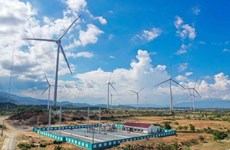Hai Phong hoped to complete industrialisation, modernisation by 2025
The northern port city of Hai Phong should generally complete industrialisation and modernisation by 2025 and become a modern industrial city comparable to those in Southeast Asia by 2030, according to a recent resolution from the Politburo.
 Nam Hai-Dinh Vu Terminal in Dinh Vu-Cat Hai Economic Zone of Hai Phong city (Photo: VNA)
Nam Hai-Dinh Vu Terminal in Dinh Vu-Cat Hai Economic Zone of Hai Phong city (Photo: VNA)Hai Phong (VNA) – The northern port city of Hai Phong should generally complete industrialisation and modernisation by 2025 and become a modern industrial city comparable to those in Southeast Asia by 2030, according to a recent resolution from the Politburo.
Resolution No.45-NQ/TW that focuses on the development of the city was issued on January 24.
Accordingly, the Politburo has set the target that Hai Phong will take the lead in industrialisation and modernisation in Vietnam to become a driving force of development for the northern region, as well as the whole country.
It will have modern, smart, and sustainable industries, along with uniform and modern traffic infrastructure to seamlessly connect domestic and international destinations through road, rail, sea, and air routes. The city is also hoped to become an international centre for education, training, research, application, and development of science-technology and marine economy.
Meanwhile, the material and spiritual lives of local people must also be improved to be on par with those in major Asian cities, the resolution said.
Aside from the general completion of industrialisation and modernisation, Hai Phong also needs to strive to make up 6.4 percent to Vietnam’s gross domestic product (GDP) by 2025. Its gross regional domestic product (GRDP) will grow by at least 13 percent on average between 2018 and 2025, while the annual per capita GRDP will reach 14,740 USD.
Hai Phong must also strive to become a modern, smart, and sustainable industrial city comparable to those in Southeast Asia by 2030. By that time, its contribution to the country’s GDP is hoped to reach 8.2 percent, with an average GRDP growth rate of at least 12.5 percent between 2026 and 2030, and the annual per capita GRDP at 29,900 USD.
The Politburo hopes that Hai Phong will reach a high development level among leading Asian cities by 2045. –VNA












